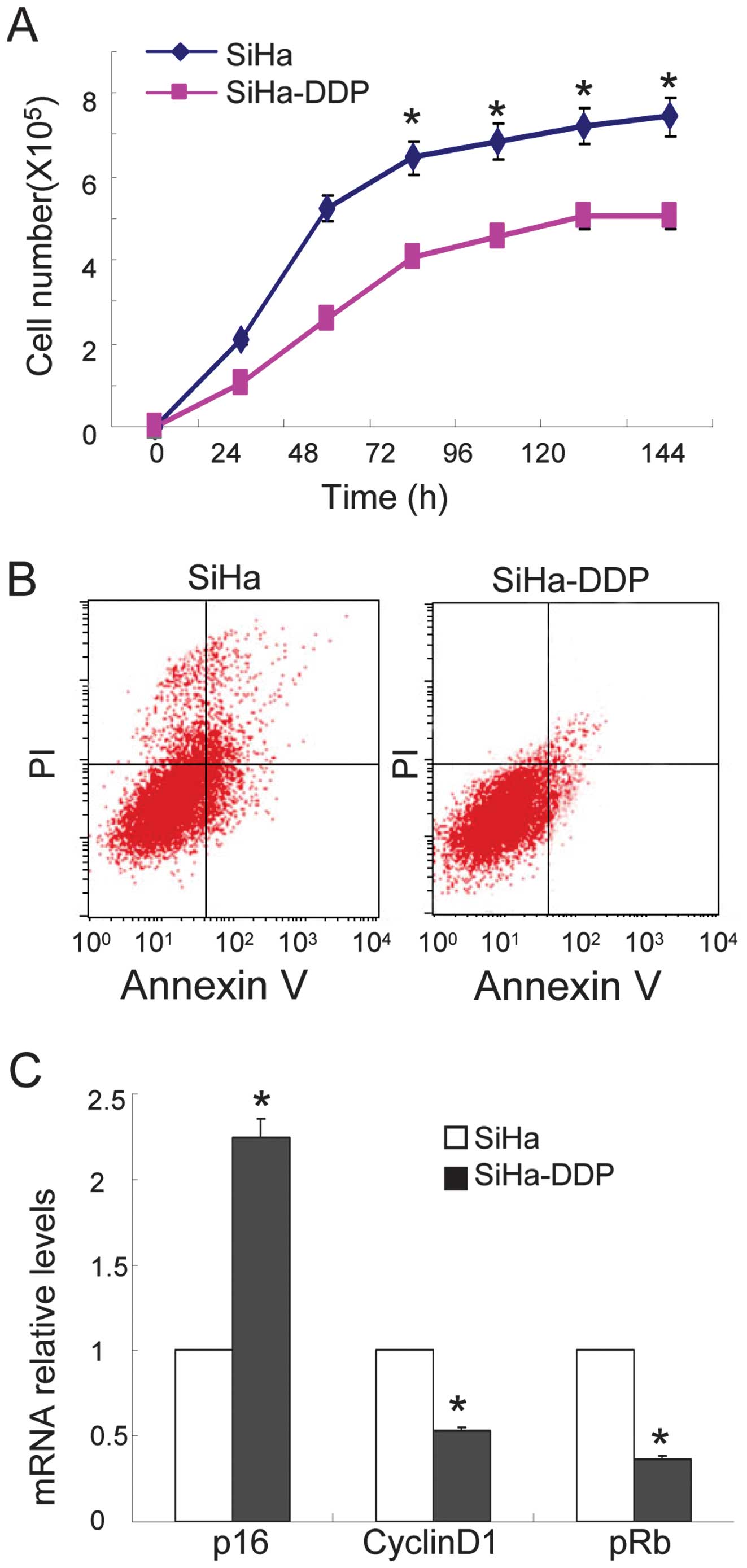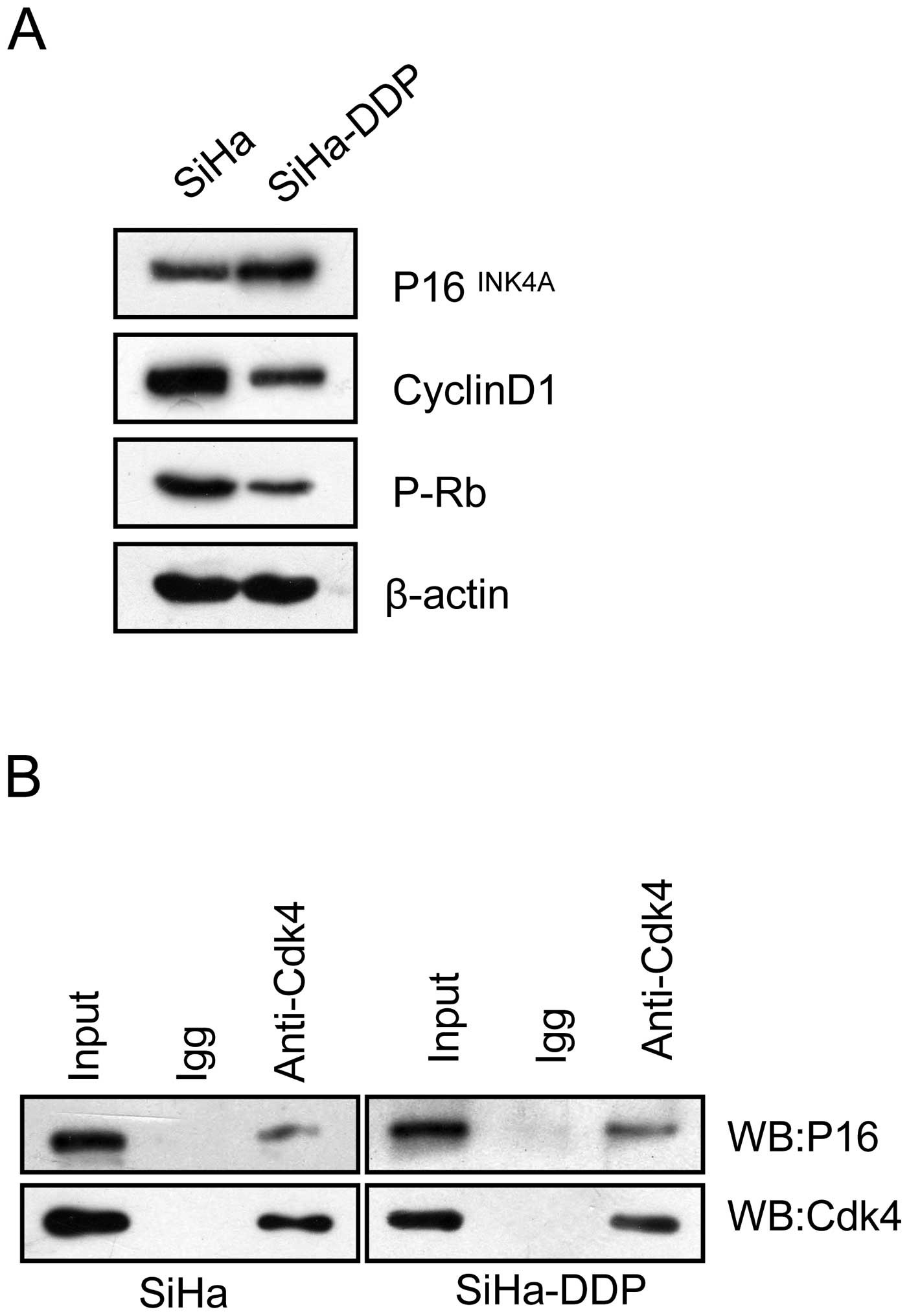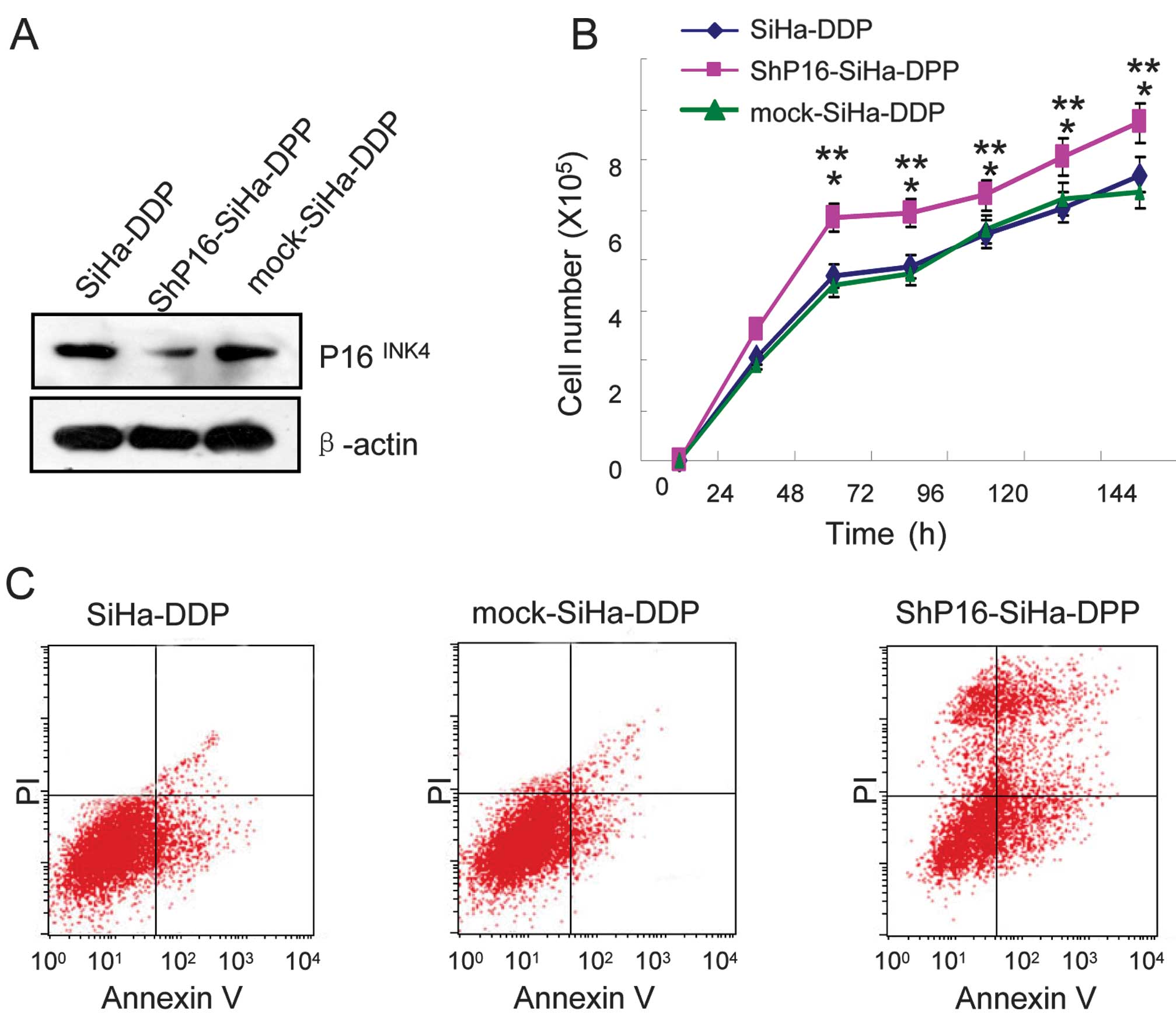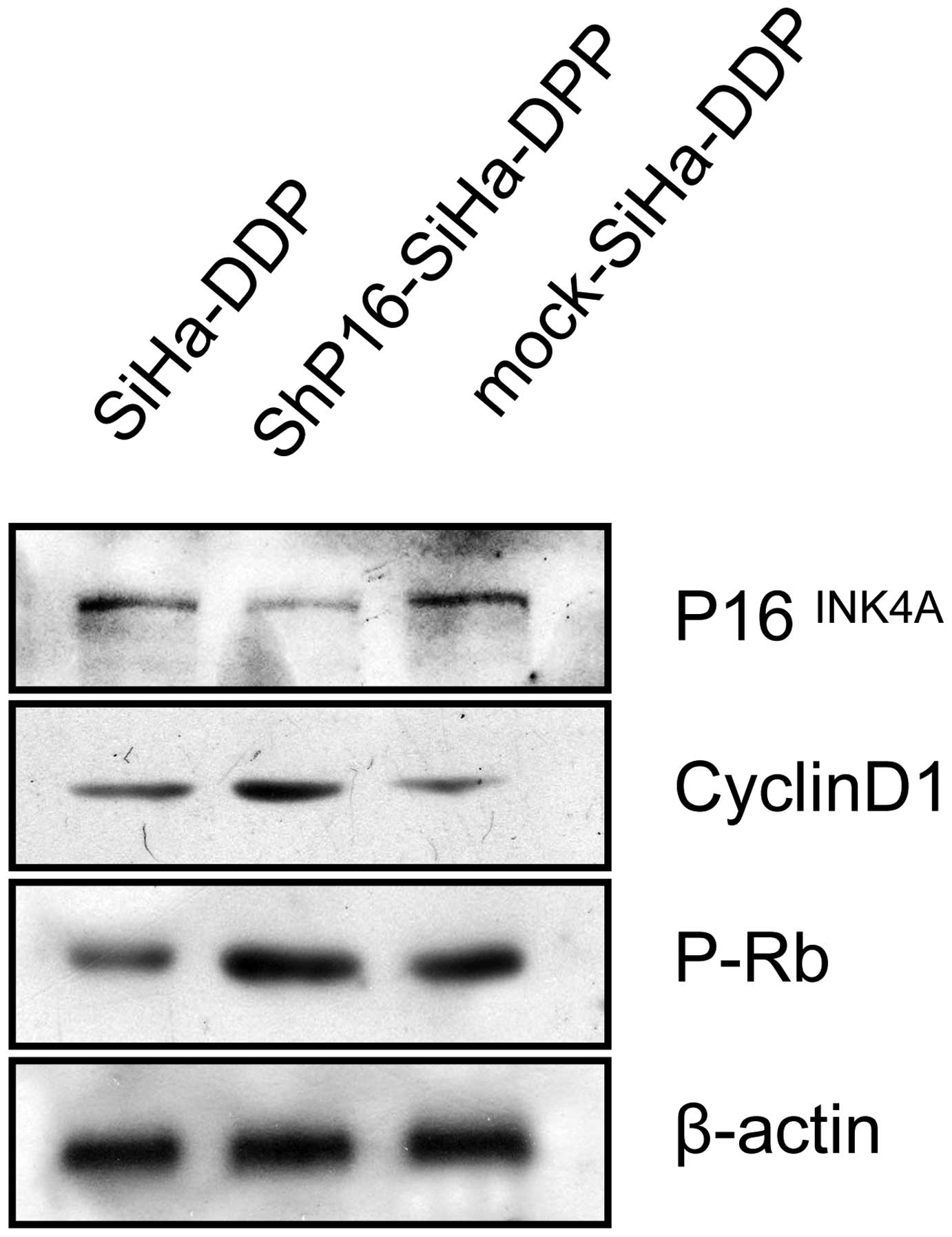P16INK4A is required for cisplatin resistance in cervical carcinoma SiHa cells
- Authors:
- Published online on: December 19, 2014 https://doi.org/10.3892/ol.2014.2814
- Pages: 1104-1108
-
Copyright: © Li et al. This is an open access article distributed under the terms of Creative Commons Attribution License.
Abstract
Introduction
Cervical cancer is the third most commonly diagnosed cancer and the fourth leading cause of cancer-related mortalities in females worldwide. Cervical cancer accounted for 9% (529,800) of all newly diagnosed cancer cases and 8% (275,100) of all cancer-related mortalities among females, worldwide in 2008 (1) and >85% of these cases and mortalities occurred in developing countries (1). According to the American Cancer Society, the five-year relative survival rate for uterine cervical cancer diagnosed between 2002 and 2008 in the USA was 69% (2). At present, standard treatment for cervical carcinoma treatment involves surgery, chemotherapy and radiotherapy. Combined chemotherapy using cisplatin (DDP) has been widely approved for the clinical treatment of cervical carcinoma. Furthermore, a marked decrease in mortality of patients has been observed with DDP-containing chemotherapy schemes in cervical carcinoma treatment (3,4). The efficacy of DPP appears to be a result of its ability to enter cells via multiple pathways and produce multiple DNA-platinum adducts, which initiate the apoptotic pathway, resulting in cell death (5). At present, DDP remains a front-line clinical therapy and constitutes part of the treatment regimen for patients with various types of cancer. However, drug resistance has become a major challenge associated with successful DDP treatment of cervical carcinoma. In addition, the molecular basis for resistance remains unclear.
DNA-platinum adducts may initiate a cellular self-defense system, resulting in significant epigenetic and/or genetic alternations. Previous studies have demonstrated that the mechanisms underlying DDP resistance are associated with supporting cell survival, including cell growth-promoting pathways, apoptosis, developmental pathways, DNA damage repair and endocytosis (6).
In human papillomavirus (HPV) infected cervical carcinoma, the HPV virus produces E6 and E7 proteins (7) that inactivate cyclin-dependent kinase inhibitors (CKI), including P16INK4A and retinoblastoma protein (Rb), or cause the overexpression of cyclin D that releases active E2F, which induces cell cycle traversal (8). It has been reported that irreversible proliferation arrest is a drug-responsive program, able to influence the outcome of cancer chemotherapy (9). Certain CKIs, including P21, P27 and p53, regulate DDP resistance (8) by mediating the apoptotic pathway (10,11). However, the association between the cell cycle and DDP resistance in HPV-infected cervical carcinoma requires further study. The tumor suppressor and CKI, P16INK4A, which is usually overexpressed in cervical carcinoma, is not detectable in cervical carcinomas, which are predominantly sensitive to DDP (12,13), and the cyclin D-CDK4,6/p16/phosphorylated RB (pRb)/E2F cascade is altered in >80% of human tumors (14–17). However, the association between P16INK4A and DDP resistance in cervical carcinoma remains unclear.
In the present study, the association between p16 and DDP resistance in cevical carcinoma was investigated. The mRNA and protein expression levels of P16, Cyclin D1 and pRb in SiHa and SiHa-DDP cell lines were detected, and p16 knock down of a SiHa-DDP cell line was performed to investigate the possible mechanism of DDP chemoresistance, which may lead to the development of novel treatment strategies for chemoresistant cervical carcinoma.
Materials and methods
Cell culture and transfection of shRNA
SiHa and SiHa-DPP cells were purchased from Professor Wang He (West China Second University Hospital, Sichuan, China). The SiHa cell lines were cultured in Dulbecco’s modified Eagle medium (DMEM; HyClone, Logan, UT, USA) supplemented with 10% fetal bovine serum (FBS; Hangzhou Sijiqing Biological Engineering Materials Co., Ltd., Hangzhou, China) and 50 U/ml penicillin and streptomycin (all from Beyotime Institute of Biotechnology, Haimen, China). Human normal oral keratinocytes were cultured in Oral Keratinocyte Medium (ScienCell Research Laboratories, Carlsbad, CA, USA) containing 5 ml oral keratinocyte growth supplement and 5 ml penicillin/streptomycin solution. Transfection was performed when cells had reached ~80% confluency. P16 shRNA (shP16) and the control shRNA (0.1 mg; mock) (Santa Cruz Biotechnology, Inc., Santa Cruz, CA, USA) vectors were transfected with lipofectamine LTX reagent with PLUS reagent (Invitrogen Life Technologies, Carlsbad, CA, USA). Following transfection, the cells were isolated using culture medium. Western blot analysis was then performed to determine the efficiency of p16 knockdown.
mRNA expression analysis
Total RNA was isolated using TRIzol Reagent (Invitrogen Life Technologies) and reverse transcription was performed using the PrimeScript™ First Strand cDNA synthesis kit (Takara Biotechnology Co., Ltd., Dalian, China) according to the manufacturer’s instructions. cDNA was generated from 5 mg of total RNA, also according to the manufacturer’s instructions. Reverse transcription (RT) real-time quantitative polymerase chain reaction (qPCR) was performed to evaluate the expression levels of P16 mRNA in the SiHa cell lines. Quantitative PCR was performed using Takara SYBR Premix Ex Taq II (Takara Biotechnology Co., Ltd.) and an ABI PRISM® 7500 Sequence Detection System (Applied Biosystems, Foster City, CA, USA). The total reaction volume was 10 μl consisting of 5 μl 2× SYBR premix EX Taq™, 0.5 μl (10 μM) PCR forward primer, 0.5 μl (10 μM) PCR reverse primer, 0.5 μl cDNA and 3.5 μl dH2O. The sequences of the gene specific primers were as follows: Forward, 5′-CCTTTGGTTATCGCAAGCTG-3′; and reverse, 5′-CCCTGTAGGACCTTCGGTGA-3′ for P16; forward, 5′-CAAGGGTCATTATGGGTTAGGC-3′ and reverse, 5′-TTAGGTGTAGGGGAGGGGAGA-3′ for pRb; and forward, 5′-AGCCACATCGCTCAGACAC-3′ and reverse, 5′-GCCCAATACGACCAAATCC-3′ for GAPDH.
Protein expression analysis
Proteins were extracted using cell lysis buffer (Beyotime Institute of Biotechnology) according to the manufacturer’s instructions. The protein concentration was quantified using the Enhanced BCA Protein Assay kit (Beyotime Institute of Biotechnology). For western blot analysis, equal amounts of total protein (20 μg) were boiled and separated by SDS-PAGE. Following electrophoresis, the protein was blotted onto a polyvinylidene fluoride membrane (EMD Millipore, Billerica, MA, USA) and blocked for 2 h at room temperature. The membranes were then incubated with human anti-mouse monoclonal p16 antibody (Sigma-Aldrich, St. Louis, MO, USA), human anti-mouse polyclonal pRb and β-actin antibodies (Cell Signaling Technology Inc., Danvers, MA, USA), human anti-rabbit monoclonal CDK4 antibody (Cell Signaling Technology, Inc.) overnight at 4°C. The membranes were then washed with Tris-buffered saline three times prior to incubation with horseradish peroxidase (HRP)-conjugated goat anti-rabbit CDK4 and HRP-conjugated goat anti-mouse p16, Rb and β-actin secondary antibodies (Beyotime Institute of Biotechnology) and visualized using an ECL substrate (Thermo Fisher Scientific, Waltham, MA, USA). The membranes were scanned using a myECL Imager (Thermo Fisher Scientific) and the relative level of protein expression was analyzed by ImageJ software (imagej.nih.gov/ij/).
3-(4,5-dimethyl-thiazol-2-yl)-2,5-diphenyltetrazolium bromide (MTT) assay
Cells proliferation was measured by MTT assay (Funakoshi Co., Tokyo, Japan) (20) in 96-well microculture plates (Thermo Fisher Scientific). The cells were seeded at a density of 1×104 cells/well in 96-well plates in DMEM containing 10% FBS. Three duplicate wells were set up for each group and the experiment was peformed in triplicate. After 48 h incubation, 20 μl MTT solution (5 mg/ml) in phosphate-buffered saline (PBS; Beyotime Institute of Biotechnology), was added to each well for 4 h. The absorbance of each well was analyzed using an Infinite F50 microplate reader (Tecan, Männedorf, Switzerland) at a wavelength of 570 nm. Proliferation curves were plotted according to the optical density.
Apoptosis assay
Apoptosis detection was carried out using Annexin V flow cytometry (Becton Dickinson, San Jose, CA, USA) as previously described (21). Cells were treated with 2 mM DDP or left untreated, and adherent cells were then harvested after 72 h and washed in cold PBS, centrifuged at 200 × g at 4°C for 5 min and resuspended in Annexin-binding buffer. Annexin V and propidium iodide (Invitrogen Life Technologies) were added to the cell resuspension and the stained cells were analyzed by flow cytometry using the S3 cell sorter (Bio-Rad, Hercules, CA, USA) at wavelengths of 530 and >575 nm.
Statistical analysis
Statistical significance was determined using SPSS, version 16.0 (SPSS, Inc., Chicago, IL, USA). P<0.05 was considered to indicate a statistically significant difference. Data are expressed as the mean ± standard error of the mean.
Results
High P16INK4A expression is associated with reduced cellular growth and apoptosis in SiHa-DPP cells
The DDP-sensitive and -resistant cervical carcinoma cell lines were used to compare DDP responses. MTT assay and flow cytometry were performed to identify the characteristics of human cervical cancer cells (SiHa) and SiHa-DDP cells. As shown in Fig. 1A, reduced cellular growth was observed in the SiHa-DDP cells when compared with SiHa cells, and less apoptosis was observed in SiHa-DDP cells following treatment with DDP (Fig. 1B). qPCR demonstrated that the levels of P16INK4A increased (Fig. 1C) while cyclin D1 and pRb levels were downregulated in SiHa-DDP cells when compared with SiHa cells. These results indicate that SiHa cells resistance to DDP was associated with high P16INK4A expression levels.
Levels of P16INK4A-CDK4 complex increase in SiHa-DPP cells with pRb inactivation
It has been hypothesized that the cyclin D1-CDK4-pRb pathway causes DDP resistance via cell cycle arrest (14,15). Therefore, the influence of P16 on the cyclin D1-CDK4-pRb pathway in SiHa-DPP cells was analyzed. Co-immunoprecipitation was performed to evaluate the interaction between P16INK4A and CDK4 in SiHa-DDP cells and SiHa cells. The results showed that P16 was coprecipitated with CDK4 in both cell lines (Fig. 2A), and the interaction in SiHa-DDP was enhanced when compared with SiHa cells, indicating that the P16-CDK4 complex existed and may be involved in DDP-resistance. To investigate whether the enhanced levels of the P16-CDK4 complex contributes to cell cycle arrest, western blot analysis was performed to detect changes in pRb activity. As shown in Fig. 2B, pRb levels decreased concurrently with the upregulation of P16INK4A protein levels in SiHa-DDP cells, indicating that P16 may compete with cyclin D1 to interact with CDK4, thus inhibiting pRb activation associated with DDP-resistance in SiHa-DDP cells.
Knockdown of P16INK4A induces growth and apoptosis in cells treated with DDP
To investigate whether P16INK4A regulates cellular growth and apoptosis in SiHa-DPP cells and contributes to DDP-resistance, shRNA and mock of P16INK4A were transfected into SiHa-DPP cells. Western blot analysis was used to evaluate the protein levels of P16INK4A. It was indicated that P16INK4A in shRNA-transfected cells was markedly downregulated when compared with mock-transfected cells (Fig. 3A). To investigate the proliferative effects in shP16-transfected cells, cellular growth was monitored for 144 h. The shP16-transfected SiHa-DPP cells exhibited a significant increase in cellular growth when compared with mock-transfected cells (P=0.05; Fig. 3B). Therefore, the effect of DDP treatment on the sensitivity of P16INK4A knockdown cells to DNA damage was assessed. Flow cytometry revealed that shP16-transfected cells were more sensitive to DDP-induced apoptosis when compared with mock-transfected cells (Fig. 3C).
P16INK4A inactivates pRb in SiHa-DDP cells
To identify the mechanism by which downregulated P16INK4A influences proliferation, which contributes to DDP resistance, the protein expression of pRb and cyclin D1 in SiHa, mock-transfected SiHa-DDP cells and shP16-transfected SiHa-DDP cells was investigated. pRb and cyclin D1 were significantly increased in shP16-transfected SiHa-DDP cells (Fig. 4).
Discussion
Rapidly proliferating cancer cells may be successfully killed by numerous chemotherapeutic drugs; however, several healthy proliferating cells are also damaged in the process, including hair follicle cells, intestinal cells and hematopoietic precursors. This nonselective killing of rapidly proliferating healthy cells often causes adverse effects in cancer patients. Several studies have indicated that CKIs may be used to protect normal cells from the toxicity caused by chemotherapy (8).
The cyclin D-CDK4,6/p16/pRb/E2F cascade has been found to be altered in a number of tumors (18). During the G1 phase of the cell cycle, Rb is inactivated by sequential phosphorylation events, which are mediated by various CKIs, including P16INK4A, which leads to the release of the E2F transcription factors and promotion of the cell cycle. It appears that the threshold level of the E2F1 protein, as well as the cell type, determine the function of the gene (17). DDP-resistant cells exhibited less and delayed growth when compared with non-resistant (siHa) cells (13). A reasonable explanation may be that the depressed growth of siHa-DDP cells was attributable to an elevated cellular p16 level, which caused proliferation arrest.
In the present study, SiHa human cervical carcinoma cells, which are known to be infected with HPV, were used (8). The results showed high P16INK4A expression and its enhanced interaction with CDK4 in cervical carcinoma DDP-resistance cells (SiHa-DPP), which may cause irreversible proliferation arrest. Knockdown of P16INK4A induced cells exiting the G1 phase into the S phase and promoted their proliferation, which enhanced DDP chemosensitivity as DDP targets cells in the S phase. Previous studies have revealed that the induction of P16INK4A, p21Waf1 or p27Kip1 lead to significant resistance to DDP-mediated cytotoxicity in the human cervical cancer cells, but not in the SiHa cells (19). This indicated that high expression of p16INK4A in SiHa-DDP cells was required for DDP resistance, but did not cause it, implying that additional factors coordinated with P16INK4A, leading to DDP resistance in HPV-infected cervical carcinoma cells. Therefore, future studies are required to confirm the identity of such factors.
CKI-mediated resistance to chemotherapy may be a useful approach to protect normal cells from chemotherapy-induced toxicity in patients with pRb pathway-impaired cancer. Our results provided the first evidence that P16INK4A regulated DDP resistance in cervical carcinoma SiHa cells, which may lead to the development of novel strategies for the treatment of chemoresistant cervical carcinoma.
Acknowledgements
The authors would like to thank all members of the Department of Obstetrics and Gynecology, The Third Xiangya Hospital of Central South University (Changsha, China).
References
|
Jemal A, Bray F, Center MM, et al: Global cancer statistics. CA Cancer J Clin. 61:69–90. 2011. View Article : Google Scholar : PubMed/NCBI | |
|
Siegel R, Naishadham D and Jemal A: Cancer statistics, 2013. CA Cancer J Clin. 63:11–30. 2013. View Article : Google Scholar : PubMed/NCBI | |
|
Kondagunta GV, Sheinfeld J, Mazumdar M, et al: Relapse-free and overall survival in patients with pathologic stage II nonseminomatous germ cell cancer treated with etoposide and cisplatin adjuvant chemotherapy. J Clin Oncol. 22:464–467. 2004. View Article : Google Scholar : PubMed/NCBI | |
|
Einhorn LH: Role of the urologist in metastatic testicular cancer. J Clin Oncol. 25:1024–1025. 2007. View Article : Google Scholar : PubMed/NCBI | |
|
Siddik ZH: Cisplatin: mode of cytotoxic action and molecular basis of resistance. Oncogene. 22:7265–7279. 2004. View Article : Google Scholar | |
|
Shen DW, Pouliot LM, Hall MD and Gottesman MM: Cisplatin resistance: a cellular self-defense mechanism resulting from multiple epigenetic and genetic changes. Pharmacol Rev. 64:706–721. 2012. View Article : Google Scholar : PubMed/NCBI | |
|
del Moral-Hernández O, López-Urrutia E, Bonilla-Moreno R, Martínez-Salazar M, Arechaga-Ocampo E, Berumen J and Villegas-Sepúlveda N: The HPV-16 E7 oncoprotein is expressed mainly from the unspliced E6/E7 transcript in cervical carcinoma C33-A cells. Arch Virol. 155:1959–1970. 2010. View Article : Google Scholar : PubMed/NCBI | |
|
Schmidt M and Fan Z: Protection against chemotherapy-induced cytotoxicity by cyclin-dependent kinase inhibitors (CKI) in CKI-responsive cells compared with CKI-unresponsive cells. Oncogene. 20:6164–6171. 2001. View Article : Google Scholar : PubMed/NCBI | |
|
Rebbaa A: Targeting senescence pathways to reverse drug resistance in cancer. Cancer Lett. 219:1–13. 2005. View Article : Google Scholar : PubMed/NCBI | |
|
Koster R, di Pietro A, Timmer-Bosscha H, Gibcus JH, van den Berg A, Suurmeijer AJ and Bischoff R: Cytoplasmic p21 expression levels determine cisplatin resistance in human testicular cancer. J Clin Invest. 120:3594–3605. 2010. View Article : Google Scholar : PubMed/NCBI | |
|
Mandic R, Schamberger CJ and Müller JF: Reduced cisplatin sensitivity of head and neck squamous cell carcinoma cell lines correlates with mutations affecting the COOH-terminal nuclear localization signal of p53. Clin Cancer Res. 11:6845–6852. 2005. View Article : Google Scholar : PubMed/NCBI | |
|
Sari Aslani F, Safaei A, Pourjabali M and Momtahan M: Evaluation of Ki67, p16 and CK17 markers in differentiating cervical intraepithelial neoplasia and benign lesions. Iran J Med Sci. 38:15–21. 2013.PubMed/NCBI | |
|
Vogelstein B and Kinzler KW: Cancer genes and the pathways they control. Nat Med. 10:789–799. 2004. View Article : Google Scholar : PubMed/NCBI | |
|
Nevins JR: The Rb/E2F pathway and cancer. Hum Mol Genet. 10:699–703. 2001. View Article : Google Scholar : PubMed/NCBI | |
|
Kaye FJ: RB and cyclin dependent kinase pathways: defining a distinctionbetween RB and p16 loss in lung cancer. Oncogene. 21:6908–6914. 2002. View Article : Google Scholar : PubMed/NCBI | |
|
Giacinti C and Giordano A: RB and cell cycle progression. Oncogene. 25:5220–5227. 2006. View Article : Google Scholar : PubMed/NCBI | |
|
Crosby ME and Almasan A: Opposing roles of E2Fs in cell proliferation and death. Cancer Biol Ther. 3:1208–1211. 2004. View Article : Google Scholar | |
|
Pei XH and Xiong Y: Biochemical and cellular mechanisms of mammalian CDK inhibitors: a few unresolved issues. Oncogene. 24:2787–2795. 2005. View Article : Google Scholar : PubMed/NCBI | |
|
Chen XL, Wang H, Zhang XM, et al: Establishment of a cisplatin-resistant human cervical cancer cell line. Sichuan Da Zue Zue Bao Yixue Ban. 43:151–155. 2012.(In Chinese). | |
|
Uchida F, Uzawa K and Kasamatsu A: Overexpression of CDCA2 in human squamous cell carcinoma: correlation with prevention of G1 phase arrest and apoptosis. PLoS One. 8:e563812013. View Article : Google Scholar : PubMed/NCBI | |
|
Al-Khalaf HH, Colak D and Al-Saif M: p16 (INK4a) positively regulates cyclin D1 and E2F1 through negative control of AUF1. PLoS One. 6:e211112013. View Article : Google Scholar |













